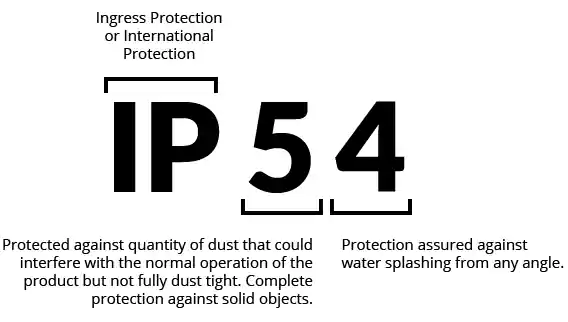IP54 is one of the most common ingress protection (IP) ratings used for electrical guide cabinets, industrial enclosures, and outdoor equipment. It defines a specific level of defense against dust and water, based on the international standard IEC 60529. For equipment manufacturers and engineers, understanding the IP54 code is essential for selecting suitable products for semi-industrial or semi-outdoor environments.
IP54 Meaning Explained
The IP54 code breaks down as follows:
- 5 – Dust protected: Complete protection against harmful dust accumulation, though not entirely dust-tight.
- 4 – Splash protection: Protection against water splashes from any direction.
Together, IP54 enclosures ensure that internal components are safe from limited dust ingress and accidental splashing water, making them ideal for many industrial and commercial applications.
Image Illustration

This level of protection is sufficient for most indoor installations and partially covered outdoor uses, including manufacturing plants and power stations.
Typical Applications of IP54 Cabinets
- Indoor industrial aparamenta enclosures
- Machine control panels in manufacturing lines
- Outdoor telecom equipment (protected zones)
- Electrical cabinets in transportation stations
- Power distribution boxes for solar or wind energy systems
IP54 vs Other IP Ratings
| IP Rating | Dust Protection | Water Protection | Recommended Use |
|---|---|---|---|
| IP44 | >1 mm objects | Splashing water | Indoor/light-duty |
| IP54 | Limited dust | Splashing water | Semi-industrial |
| IP55 | Dust-protected | Water jets | Outdoor systems |
| IP65 | Dust-tight | Strong water jets | Harsh environments |
| IP67 | Dust-tight | Immersion | Submersible equipment |
En comparación con IP44, IP54 provides improved protection against both dust and water, without the cost or bulk of full waterproof models like IP66.
Global Standards and Compatibility
IP54 is recognized worldwide and commonly complies with:
- IEC 60529 – International standard for ingress protection
- EN 60598 – For lighting equipment
- CE y RoHS regulations in Europe
- NEMA 3/3S equivalent in the United States
- GB/T 4208 standard in China
Manufacturers like ABB, Legrand, PINEELEy Schneider Electric offer IP54-rated control cabinets for use in light-industrial environments.
Benefits of IP54 Electrical Enclosures
- Resistant to workplace dust and airborne particles
- Safe for use in humid or moist locations
- Reliable protection for electrical systems
- Durable housing that complies with export regulations
- Suitable for both surface and flush-mounting applications
When Should You Use IP54?
Choose IP54-rated enclosures when:
- The area is dusty, but not extreme (e.g. not construction sites).
- Water exposure is occasional and non-pressurized.
- Compliance with CE and IEC standards is required.
- The cost needs to be balanced with functionality.
Avoid using IP54 enclosures in:
- Full outdoor exposure to heavy rain
- Environments with pressurized water cleaning
- Underground or submerged installations
Preguntas frecuentes
A: Yes, but only in protected outdoor environments, such as under eaves or shelters. For full weather exposure, IP65 or higher is recommended.
A: It means the enclosure is dust-protected. It will prevent dust from interfering with internal equipment but is not completely dust-tight.
A: In most light-industrial and manufacturing settings, yes. However, if the environment includes strong jets of water, oil mist, or conductive dust, a higher rating is safer.
IP54 is a balanced, cost-effective ingress protection rating suitable for a wide range of electrical equipment. It is particularly popular in manufacturing, light-industrial, and commercial settings where some dust and moisture are expected but not extreme. For brands like PINEELE, producing IP54-compliant control cabinets ensures compliance, durability, and safety across diverse global markets.
Get a printable version of this page as a PDF.